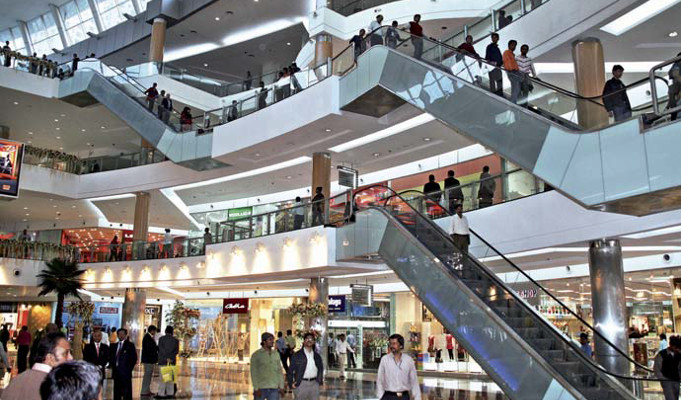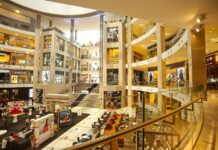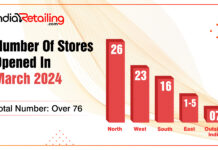While India’s long term growth outlook remains intact, there is no denying the ongoing volatility in the market at this time. Across the industry sectors, 2019 has been a year of uncertainty and vulnerability due to the rise of technology, new formats and changing customer preferences and buying patterns. However, the proactive approach of the government and reforms rolled out in recent times has set India in the growth trajectory in the long term.
Over the last decade, India has attracted global investment and moved up its ranking in terms of ‘ease of doing business’. Allowing foreign investment up to 100 percent in retail, GST reforms, a booming e-commerce sector and the development of retail real estate have unfolded a new era for organised retail.
Today, India is the world’s fifth-largest global destination in the retail space. The retail market in India is projected to reach US$ 1.375 trillion, while the Indian e-commerce industry is expected to cross the US$ 200 billion mark by 2026.
The e-commerce market in India is also set to grow at a CAGR of 30 percent for gross merchandise value to reach US$ 200 billion by 2026, with a market penetration of 12 percent compared to 2 percent currently(Source: investindia.gov.in).
With increased domestic demand, India’s retail sector investments doubled to reach Rs 1,300 crore (US$ 180.18 million) in 2018.
According to reports total consumption expenditure is expected to reach nearly US$ 3,600 billion by 2020 from US$ 1,824 billion in 2017.
The Rising East
With new entrants, newer formats and a booming e-commerce sector, the Indian retail industry is going through an interesting phase. While mature markets are seeing a trend of consolidation, new emerging markets are also coming in the radar of global brands. As compared to other regions, East India with states like West Bengal, Bihar, Jharkhand, Orissa and the entire North East states of Assam, Arunachal, Tripura Mizoram, have been late bloomers. However, brands and marketers are now shifting their focus from mature markets to these emerging cities in a bid to explore new opportunities.
A lot has changed in the last decade with penetration of internet connectivity and retail real estate developments. With Millennials having higher disposable incomes, growing fashion awareness and increased aspirations, the states in the eastern part of India have been drawing a lot of attention of the retail industry as a whole. And even though the region is considered a conservative market, factors like a growing consumption trend, good transportation infrastructure, availability of retail real estate infrastructure have propelled growth in this region.
While Kolkata has been the hotbed of organised retail activities, markets like Bhubaneswar, Patna, Siliguri, Guwahati, Tinsukia, Ranchi, Dhanbad, Bokaro, Jamshedpur with their huge base of population and demography have been drawing the attention of investors.
1. Kolkata
The region has its distinctive consumption pattern and quintessential characteristics. Unlike other regions in the country, the east has always been known for being a price sensitive market. However, the buying behaviour of consumers is evolving rapidly. Kolkata has been the center point of retail development activities and the city houses a few of the country’s most successful shopping centre formats. With a significant influx of migrated population from the neighbouring states and countries, Kolkata has become a retail hub for the region.
Traditional and modern retail formats are running parallelly here to cater to customers’ needs.
Led by RPSG group, Spencer’s Retail has pioneered the hyper market and supermarket format in the city. Large format stores like FBB, Pantaloons, Reliance Trends, Shoppers Stop are the leading large format stores dominating the city’s retail scene. The city’s fashion retail landscape also includes some of the most successful malls of the country like Quest Mall, South City Mall, Acropolis, Mani Square, City Centre Salt Lake, City Centre New Town housing all major global fashion brands. The city also houses a luxury fashion mall housing brands like Canali, Gucci and Burberry.
Fashion retail destinations here include high streets like New Market, Camac Street etc. Apart from this, Kolkata is also home some major footwear brands including Khadim’s and SreeLeathers. Food & Beverage is also a major retail category in the city and fast food chains like Pizza Hut, KFC, Wow! Momo are witnessing phenomenal growth. Kolkata, with its cosmopolitan population base and a steady inflow of tourists from neighbouring countries has huge potential, just waiting to be explored by retail brands.
2. Siliguri
Another retail centre of West Bengal witnessing major growth of organised retail is Siliguri. Situated close to Nepal, Bhutan, Sikkim and Bangladesh, Siliguri is the business hub of North Bengal. Traditionally high street areas are Hill Cart Road and Sevoke Road. The demographic profile in the city has attracted almost all major players. Growth in overall population with increased consumption has fuelled retail real estate boom. Currently, the city has approximately 1.2 million sq ft operational mall space offering a mix of various global and international brands. The major malls like City Centre Siliguri, Cosmos Mall, Vega Circle are the retail hotspots which are very popular amongst shoppers of all age groups.
3. Durgapur
Another major town – a key industrial and commercial hub – is Durgapur, which serves as a junction for all routes going North and Northeast. It is primarily driven by steel and allied industries and is home to the Durgapur Steel Plant. It even boasts a well-connected rail road infrastructure. Durgapur’s Junction Mall, developed by Shrachi PGE, is spread over 370,000 sq. ft. The mall offers an interesting tenant mix giving exposure to national and international brands. The city’s huge population with high disposable incomes have attracted large formats like Big Bazaar, Reliance Trends, Spencer’s Hyper and More to open up standalone stores.
4. Asansol
Asansol is the second largest city after Kolkata in the east and has seen significant development of organised retail. Pathak Bari one of the main retail markets has a number of traditional retailers. Owing to growing consumerism, the city has a mix of traditional and modern retail. It has a number of traditional retailers who dominate. However, in the last few years, the city has seen drastic changes in its retail and retail real estate dynamics.
The city has two operational malls: Asansol Sentrum Mall developed by Bengal Shristi Infrastructure Development and Galaxy Mall developed by Srijan Realty and Avani Group. Spread over 2.5 lakh sq. ft., Asansol Sentrum offers many brands like Hoff men, Jockey, Moustache, Brand Factory etc. The city’s prime retail market area is Chitra More with a number of local MBOs catering to high street shoppers.
5. Guwahati
Many shopping malls and big retail outlets and standalone stores have come up at different places in the capital of Assam and the largest city in the Northeastern region, Guwahati – the new retail hotspot of the Northeast. Being the ‘Gateway of Northeastern’ region, Guwahati is a hub of economic development. In the last five years, the city has witnessed phenomenal growth of organised retail across various formats and verticals. G S Road, Fancy Bazaar, Paltan Bazar are prime markets which have witnessed paradigm shift in recent years. Large format national retail players like Pantaloons, Big Bazaar, Reliance Trends, FBB, Vishal Mega Mart, Westside are catering to the city’s growing consumer base.
The market is going through a major shift in mindset and lifestyle of people. This has fuelled consumption to a great extent. In the last 10 years, Guwahati has seen franchisee stores of national/ international brands mushrooming in Paltan Bazar, Christian Basti and GS Road. The city is home to some of the bigger malls namely, Central Mall (spread over 1,40,000 sq ft), City Centre Guwahati (4 lakh sq. ft) and The Hub (over 55,000 sq. ft.) etc.
G S Road is the high street of the city, which houses exclusive brand stores of all leading brands. As a market, Guwahati has immense potential and people are fashion forward compared to even the metros like Mumbai. Consumption for fashion is high so one can expect more malls to come up in areas like Fancy Bazar, Paltan Bazar and Dispur. As of now G S Road the most coveted retail destination, although unreasonable rentals can be deterrent for the growth of retail brands.
6. Jorhat
Being a gateway to Nagaland and Assam, Jorhat has emerged a significant market for organised retail. Jorhat has a number of tea estates which drive the town’s economy. Consumer profile is fast evolving, drawing attention of corporate retailers. Jorhat has a good population of local Assamese people who are fashion conscious and are willing to spend on brands inspite of living in a small town.Hence, the market is lucrative for retailers. Brands like Cantabil, W, Manyavar, Moustache, Sheriff , Adidas, Turtle, Reebok have their EBOs in the area. Amongst large formats Vishal Mega Mart and Sohum Shoppe have standalone stores.
7. Bihar & Jharkhand
The states of Bihar and Jharkhand hold a wealth of opportunity for the retail industry. There is immense scope for the organised retail sector here, considering 98 percent of retailing is currently dominated by the unorganised sector.
Patna: Patna is one among the fastest growing cities here and in India, with a huge, young population. Growing consumerism has created a demand for major national and international brands including Levi’s, Gini & Jony and Blackberry’s to name a few. The prime retail high street is Boring Road with a array of regional retailers and national brands. A growing customer base which has access to high disposable income has prompted retail formats like Big Bazaar to be bullish. Amongst the bigger formats are Vishal Megamart, Chunilal Megamart, Big Bazaar, Reliance Trends etc. The city’ high streets houses brands like Monte Carlo, Blackberry, Woodland, Sreeleathers, Khadim’s, Bata, Adidas, Levi’s, Provogue, Lee, Lilliput, Vishal Megamart, Moustache, among others. P&M Mall in Patna is the biggest operational mall with an area of 2.25 lac sq. ft.
8. Jamshedpur
A populous urban agglomeration in Jharkhand is Jamshedpur. Being home to one of the biggest steel manufacturing company, Jamshedpur has a strong population with high purchasing power. The city has immense potential for the growth of organised retail, although it lacks major large format players. The local market attracts lots of customers from surrounding areas like Bokaro, Dhanbad and Ranchi. It is primarily dominated by local retailers.
9. Bokaro
Bokaro has become an important centre for economic activities in Jharkhand. The city’s economy is primarily driven by the steel and allied industries. In the last few years, Bokaro has seen significant number of retail players opening standalone stores. In the last five years, the city’s organised retail scenario has further got a boost in the form of Bokaro Mall with Big Bazaar as its anchor store.
10. Dhanbad
Also known as the coal city of India, Dhanbad is important area for the retail industry. Till a few years ago, the city’s retail scenario was dominated by traditional retail, but all this has changed mainly because of an array of big companies and mines here including Tata Steel, IISCO, BCCL, ECL leading to a huge, untapped consumer base with spending power. Bank More is the oldest retail and commercial hub with major offices, banks, retail shops. The stretch has exclusive stores of some major national brands. In the last few years, the city has also got its first shopping centre, Ozone Galleria Mall at Saraidhela, and many large format retail brands are calling Dhanbad home, now.
11. Ranchi
Ranchi with a population of 1 million, is the 37th urban agglomeration in India. The city’s consumer profile is as good as any other metro in the country, especially since consumers here are brand conscious and willing to pay for good quality and styling. The high streets of the city are Main Road and Church Road where most national brands are present in the form of MBOs.
Amongst national retailers present here are Bata, Color Plus, Levi’s, Lilliput, Adidas, Blackberry are to name a few. Ranchi has immense potential for both malls and local MBOs who have embraced modern retail. Ranchi’s biggest mall is Nucleus Mall, which is an area of over 3.5 lacs sq. ft, followed by JD High street and LMB Springcity. The city now has stores of an array of national and international brands like US Polo, Pepe Jeans London, Scullers, Wrangler, Lee, Ray Ban, Wills Lifestyle etc.
Odisha
12. Bhubaneswar
Considered one of the top 10 fastest growing cities of India, Bhubaneswar is a hub with a population of 1 million. It is also a major IT/ITES hub in eastern India. The city’s prime retail area is Janpath where major local MBOs like Amber, Alishan, Kalamandir Fashions and SriDurga cater to retail needs.
“Today local MBOs are reinventing themselves to retain their customer base and give them a better retail experience.
Therefore, in spite of malls, MBOs are still witnessing high footfalls and conversion,” explains Manik Maheshwari, Owner, Amber.
Large formats like Big Bazaar, Reliance Trends, FBB are bullish about the market as they have seen double digit growth in the last two years. Owing to demand and high consumption, the city has witnessed major retail real estate developments.
The city houses popular malls like Utkal Kanika Galleria, Esplanade One, DN Regalia, Symphony Mall, Forum Mart and Pal Heights Forum Mart. With growing appetite of consumers, lifestyle retail categories have evolved in the region to a great extent. Despite this, the region is lagging behind in terms of attracting major investments. Absence of political will to bring in reforms and lack of job creation still remain major stumbling blocks for the growth of retail. Also, the demography of the population reflects price sensitiveness.
13. Conclusion
Quite a few challenges need to be addressed to explore the potential of the eastern region of India, which used to be highly fragmented and predominantly consisted of small independent, owner managed shops. There is a need for policy level reforms by the state governments to attract investments across industries to boost the per capital income. A robust infrastructure and manufacturing growth with ample job opportunities will also ultimately enable the local and corporate retail chains to be sustainable. For growth of brands whose prime focus is e-commerce, logistics & warehousing infrastructure development is required. In the last decade or so, the region has slowly opened up to modern retail and especially e-commerce. The right intent of the government and successful implementation of economic reforms in the region can open huge opportunities for further growth of retail in the region.








